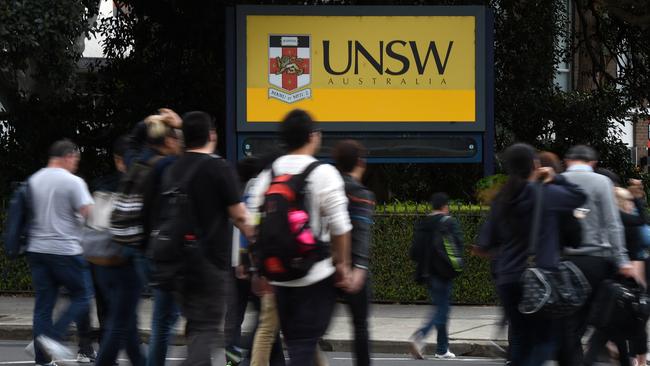Success in QS rankings shows the quality of Australian universities

This is an immense achievement and comes at one of the most pivotal moments in the history of higher education in Australian, underscoring that together our universities are a powerhouse of impact and change.
An interim report from the federal government’s Universities Accord process will be released next month and will trigger significant debate on issues ranging from the quality and accessibility of higher education to the sustainability of research funding.
The best way we can harness the power of higher education is to commit that we will tackle these challenges together, not as rivals, but as peers working to secure the future of Australia.
Looking for a better future, however, should not stop us recognising an immediate, singular achievement of our higher education system – Australia’s top universities are in league with the finest in the world. Our students experience world-class education and our researchers blaze a world-leading path.
The latest compelling evidence of this comes with the release of the authoritative QS World University Rankings. For the first time, three Australian universities placed in the top 20: the University of Melbourne ranked 14th and the institutions we lead: UNSW and the University of Sydney tied 19th.
We are in illustrious company: Oxford and Cambridge, Harvard, Stanford, MIT, Peking University and the National University of Singapore.
QS has continued to recalibrate its rankings methodology this year. They now incorporate indicators that provide, perhaps, a more roundly inferred picture of universities’ purpose and their progress in tackling society’s biggest issues. Sustainability, societal wellbeing, graduate employability, and international research collaboration have been added to the index and have helped propel Australian universities up the rankings.
Australia now has six universities in the global top 50. All of the nation’s leading research-intensive universities in the Group of Eight, and the University of Technology Sydney, are in the top 100.
It is a remarkable achievement for a country of Australia’s population and reflects the extraordinary opportunities on offer for the students, researchers and partners who study, work and collaborate with us.
Our researchers regularly engage with colleagues at the top global universities, working together to provide the breakthroughs needed to help address the vast complexities of issues – from climate change and socio-economic inequality, to nuclear subs and the rise of AI.
These are issues that are too big for any institution to tackle alone.
That’s why, as leaders of our respective institutions, we have committed to ensuring UNSW and the University of Sydney work even more closely together. We know we can achieve much more together than as traditional cross-town rivals.
Our academics are engaged in a multitude of collaborative projects, across disciplines, and with partners in government, industry and NGOs and we recognise that collaboration is how we will develop global solutions for real-world problems.
Together, we’re ensuring Australia leads the world in quantum computing. We’re using science to revive our oceans from the effects of climate change and urbanisation through our collaborations with Macquarie University and UTS in the Sydney Institute of Marine Science. And 10 per cent of University of Sydney and UNSW publications in health are now jointly authored across our institutions – we share a priority in supporting the evolution of the state’s health system.
Universities do the heavy lifting of the nation’s research and development. In 2019-20, universities did 36 per cent of Australia’s total R&D, including 87 per cent of all the discovery research and 45 per cent of the applied research. What’s more, despite having only 0.3 per cent of the world’s population, Australia’s research production is about 3 per cent of the global quantum.
But it’s not only research that sets Australia’s universities apart.
The new QS indicator of graduate employability tells part of this story: the transformative power of education. From lower financial stress to better health outcomes, more civic engagement, and a deeper pool of ‘human capital’ with the knowledge and skills the country needs, higher education holds gigantic promise.
The reputational boon today’s rankings provide for Australia’s top universities is significant. We have heightened gravitas to attract the world’s best researchers, educators and students, and for the world’s best institutions to seek our partnership. It gives us more influence to facilitate international dialogue and understanding, and to have a positive impact geopolitically.
There should be no doubt the rise of Australia’s research universities to such a strong international position correlates directly with the significant arrival of international students on our campuses, particularly over the last decade.
The strong presence of international students is a feature of all the world’s leading universities and Australia’s significant success in this area is a tribute to quality of education on offer and the great employment prospects that come from a top Australian degree.
It’s a great Australian story.
We know there is work still to be done and this is where the Accord can bring about much needed reform. We need to pay close attention to the overall university experience and ensure it meets changing student needs and expectations, particularly when it comes to partnering with the workforce on lifetime learning while ensuring equity and access.
There is no better time to have a conversation about making sure the shape and funding model for Australian higher education is purpose-built for the leaders of the future.
Professor Attila Brungs is vice-chancellor of UNSW Sydney. Professor Mark Scott is vice-chancellor of the University of Sydney.



Australian universities have just scored top marks in one of the world’s most prestigious rankings report cards.